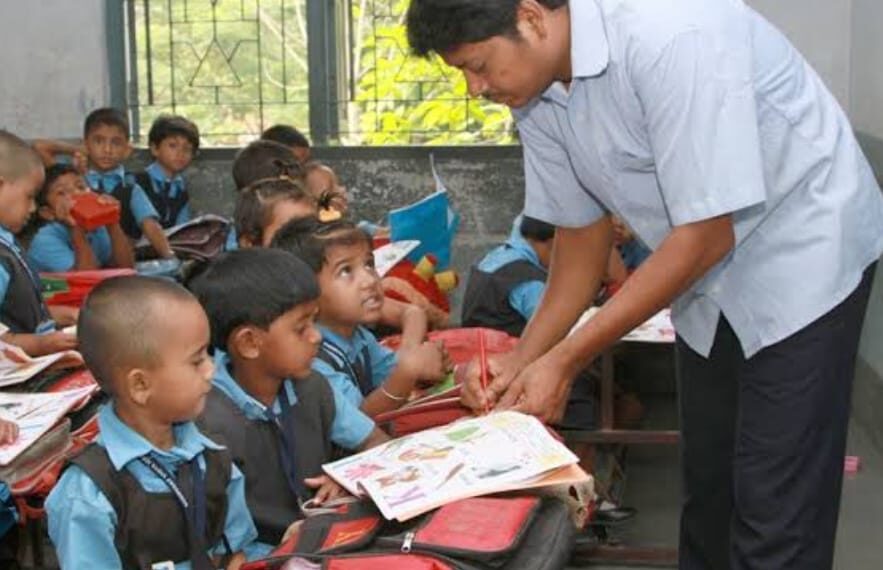Manoj K. Dash, Bhubaneswar, 12th December 2022
I was discharging a professional responsibility last month in some schools of three districts of South-western Odisha, when I spotted the following message in a neatly bound flex banner inside a classroom of a school that I visited a sunny afternoon. My first response was that of gladness that a learned, suave and affable Chief Minister is trying to convey something deeply meaningful to children. I had never seen something like this in a school before although I have visited hundreds of schools across many states.

I asked a few children whether they understand what is written on the message board to which only a few responded in the positive. It also came to my knowledge that no teacher or other stakeholder has ever tried to explain the message to children to whom it is primarily addressed. I was surprised too that the message has a serious error which has been allowed to continue without being rectified.In a nutshell, the message that is conveyed to children translated to the following:
The Hon’ble Chief Minister exhorts children to dream big and get ready to face the multiple challenges in life with aplomb. It also asks children to discharge three responsibilities namely, (a) get well educated to turn one’s dreams into reality; (b) take care of parents; (c) always make efforts to work for betterment of the nation, society and village where one is born.
These constitute a huge message which is transformational too. I kept thinking about the context of this message for quite a few days before putting down my thoughts on the subject in the public domain.
The message basically talks about dreaming, taking responsibility and turning dreams into reality. Dreaming is important but taking action to transform one’s dreams into reality is essential. If one is successful in making one’s dreams get translated into reality, one usually becomes capable enough to discharge one’s basic responsibilities towards family, parents, society, village and the nation at large. However, seeding capability in children in the domain of education needs resources. Either the resources are provided by the government or by private players for payment of a consideration amount as it happens in the real world.
For most of those living in the districts in the Southern or Western regions of Odisha, government provisioning of resources in the education domain is the only available source of seeding capability in children. However, what I witnessed there is lack of enough classrooms, lack of enough teachers, poor quality of buildings, unavailability of suitable teaching learning material or equipment, inability of teachers to handle new methods of teaching like the Fundamental Literacy and Numeracy (FLN), etc.
The Annual Survey of Education Report (ASER) of 2018 conducted by Pratham Education Foundation revealed that among children of rural Odisha in standard III, 8.6% cannot even read letters, 15.7% can read letters but not words or higher, 22.8% can read words but not standard I level text or higher, 14.2% can read standard I level text but not standard II level text, and 38.7% can read Standard II level text.
In numeracy, among children in standard III, 7.8% cannot recognize numbers 1 to 9, 24.9% can recognize numbers up to 9 but cannot recognize numbers up to 99 or higher, 36.5% can recognize numbers up to 99 but cannot do subtraction, 21.5% can do subtraction but cannot do division, and 9.4% can do division.
According to the same report, the percentage of schools where standard II children were observed sitting with one or more other classes was 79% and percentage of schools where standard IV children were observed sitting with one or more other classes was 66%.
ASER 2018 goes on to report that only 57% of schools had electricity connection, 19% of schools has a computer available for children to use, only 54% children made use of library books while about 20% schools had no library at all.
The report also mentions that on the day of visit to the school the researchers found about 80% children in the primary and upper primary schools, which could mean drop-out rate of 20% at the lower stages of school which as per anecdotal reports sharply goes up in higher classes due to multiple reasons.
With such dismal state of facilitiesav ailable in schools and their educational performance in the crucial domains of literacy and numeracy at the lower classes, what the students will do when they move up the ladder of grades? Will they be able to cope up with the demands of higher levels of conceptual and analytical understanding required to seed the capability in themselves in order to turn their dreams into reality which in turn will help them discharge their primary responsibilities well?
When the government is not able to provide a minimum set of resources that are progressively on demand to meet the needs of a dynamically evolving world, how far exhortations by the Hon’ble Chief Minister, howsoever honest it may be, would make children capable enough to turn their dreams into reality and discharge their responsibilities? In my view, it will need massive upgradation of school infrastructure and provision of modern resources that can alone get the results that the Hon’ble Chief Minister wants our children to achieve.
In the post-Covid scenario it is reported that a far greater percentage of children are not reporting at their nearby schools. High level of learning loss has been reported by parents, educationists and policy experts. All these additional challenges will make the goals highlighted in the message of the Hon’ble Chief Minister much more daunting without provision of adequate resources in the traditionally underdeveloped and under-resourced pockets of Odisha.







